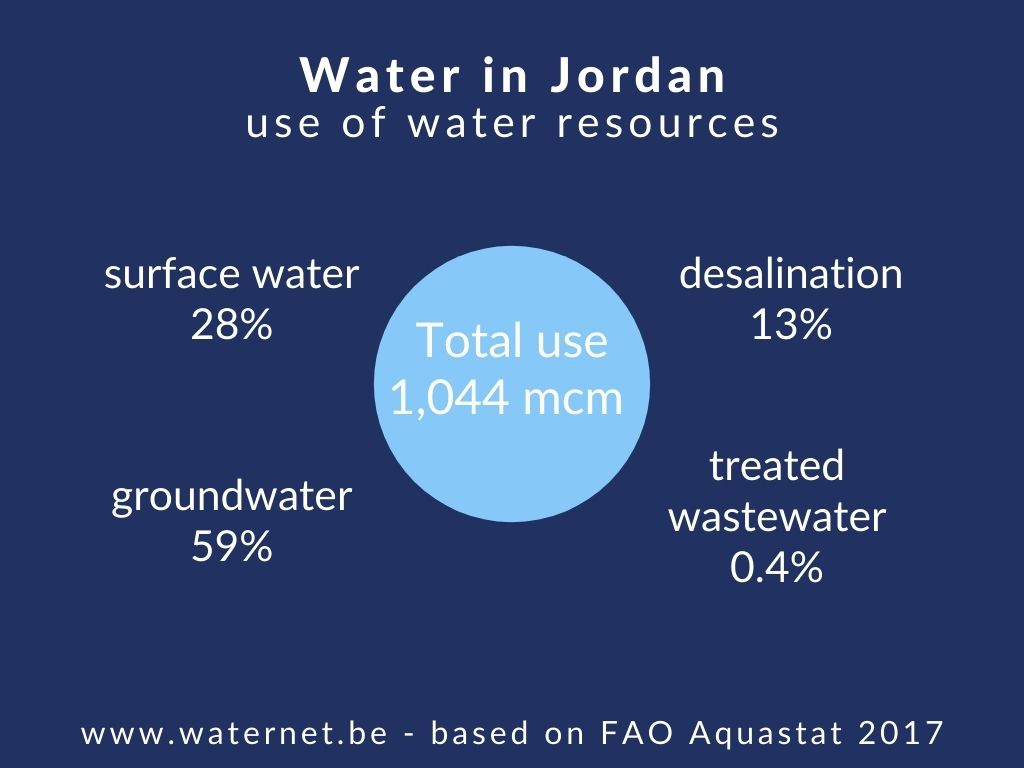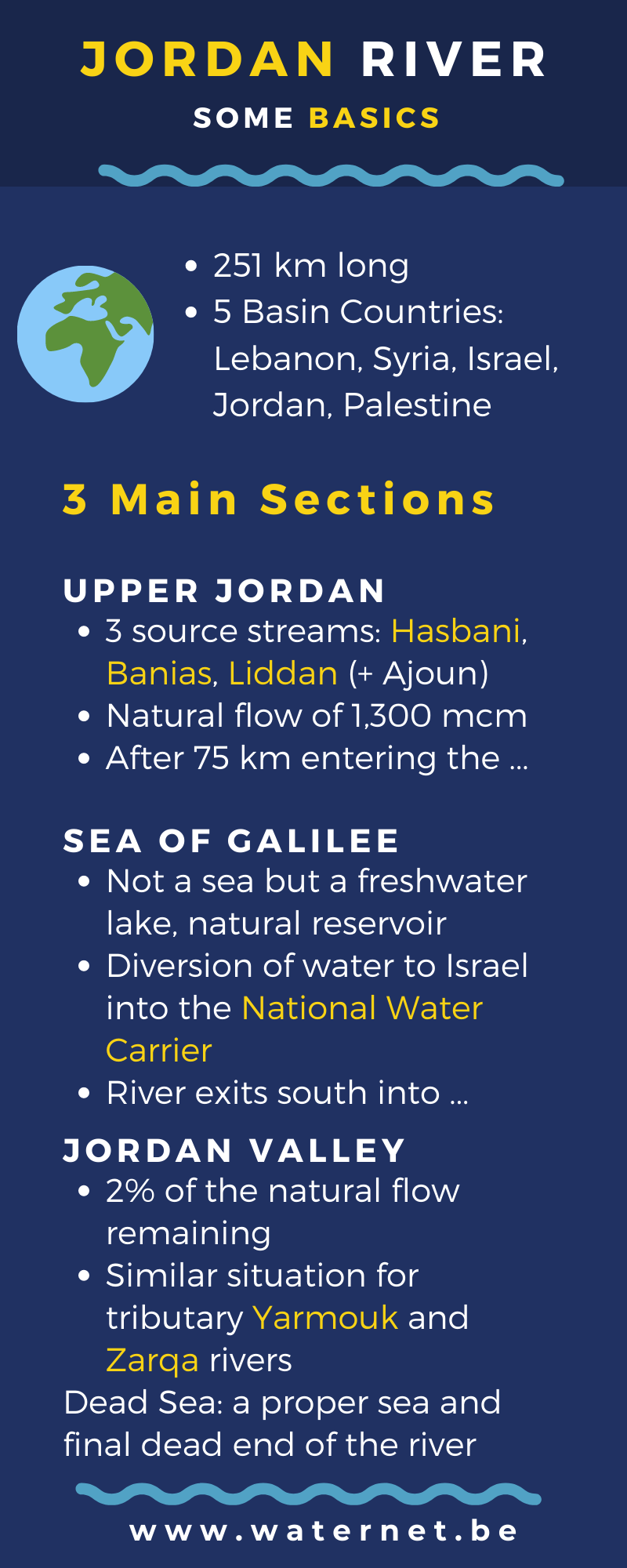This is an annotated collection of some figures on water availability, water use and access to water in Jordan.
Main challenges
- Water availability:
- Renewable water resources under severe stress
- Few alternatives available; at high cost
- Pollution: 20% of household wastewater unsafely discharged, affecting water natural water resources
- Climate change and environmental change threatens the hydrological cycle
- Water demand:
- Population growth higher than expected (Syrian refugee crisis)
- Demand is higher than renewable water resources
- Water consumption:
- 47% of water withdrawal is unaccounted for (490 million m3 or water for 4.7 million people)
- More than half of total water consumption creates only 5% of national added value
Available freshwater resources
Internal renewable resources:
- Long-term average annual percipitaton: 9.915 km3 (estimated)
- Total internal renewable water resources: 0.682 km3.
This is the amount of percipitation that feeds into the flow of rivers and recharges groundwater and aquifers. - Note that from the figures above, we can conclude that 93% of the rainfall in Jordan almost immediately evaporates or evapotranspirates into the atmosphere and doesn't reach the main surface water or groundwater systems.
Transboundary water resources:
- External renewable water resources (inflow from upstream countries, shares of border rivers and lakes): 0.165 km3
- Note that the total flow from border rivers is 0.54 km3, of which Jordan may use 0.035 km3 or less than 10%.
Border rivers are the Yarmouk and Jordan River.
- Note that the total flow from border rivers is 0.54 km3, of which Jordan may use 0.035 km3 or less than 10%.
- Groundwater entering the country: 0.27 km3
In sum: total available renewable freshwater resources in Jordan:
- 0.937 km3
- which is 95.75m3 per capita per year.
- Available water resources are not the same as exploitable resources. The latter are considered to be available for development, taking into consideration factors such as: the economic and environmental feasibility of storing floodwater behind dams, extracting groundwater, the physical possibility of storing water that naturally flows out to the sea, and minimum flow requirements (navigation, environmental services, aquatic life, etc) - (definition by Aquastat). Thus the amount of exploitable resources will be lower than the available water resources; we are still looking for usefull figures.
Source: FAO (2017), AQUASTAT Core Database. Database accessed on 22/02/2021.
Water use
 Total water use for human development (agriculture, industry, municipal) is 1.044 km3 or 1,044 million m3.
Total water use for human development (agriculture, industry, municipal) is 1.044 km3 or 1,044 million m3.
This is the amount of water that is taken out of the natural environment and artificial storage systems, from non-renewable groundwater resources, re-used drainage and wastewater or desalinated water.
This is 109% of the amount of available renewable freshwater resources (once we have the data, it will be better to compare it with the exploitable resources).
If we look more into detail, withdrawal from surface water is 288,8 million m3, and groundwater (renewable and non-renewable) is 614,8 million m3, or 903.6 million m3 in total. Desalination (136.3 million m3) and re-use of treated wastewater (4.2 million m3) are non-conventional water resources.
Read also more in the fact sheet on groundwater extraction in Jordan.
Average water use: 103 m3 per person (population size of 10.1 million in 2019).
With a score of 4.56 on the Water Stress Index, Jordan is the 5th most water stressed country in the world (See: World Resource Institute, Aqueduct country rankings).
Withdrawal per sector and relative efficiency
Of the total withdrawal of 1,044 million m3, agriculture is the biggest consumer of water in Jordan; it takes more than half of the water withdrawal but adds just 5% to the national wealth. In comparison, industry, with 3.1% adds 61% to national wealth.
Source: FAO (2021), AQUASTAT Core Database. Database accessed on 22/02/2021; UN Water (2021), Sustainable Development Goal 6 - Jordan.
Valuing water
- 47% of water in Jordan is non-revenue (leakage, unauthorized connections, and unpaid bills). This is cost that has to be absorbed by the water utilities and eventually passed to paying clients.
- The Ministry of Water and Irrigation is implementing a capital investment program on a yearly basis that costs around USD 400 million per year for rehabilitation of infrastructure, reduction of non-revenue water, and developing new water resources.
- The price for municipal water for households in Amman is 0.37 JD per m3 (US $0.52), which is very cheap regarding the national water crisis. It is not clear what the real production cost for municipal water is, but at this price water must be subsidised.
- The price for water delivery by (private) truck in Amman is 2 JD ( US$2.82) per m3 or 440% the price for municipal water.
Source: Ministery of Planning and International Cooperation, Jordan response plan for the Syria crisis 2020-2022; my monthly water bill (March 2021); my friend's water bill (March 2021).
[UNDER CONSTRUCTION: access to water - drinking water - sewage facilities (SDGs)]
Links to additional existing data sheets:
- Sustainable Development Goal 6: Jordan fact sheet (UN Water)
- FAO AQUASTAT - Jordan country profile


